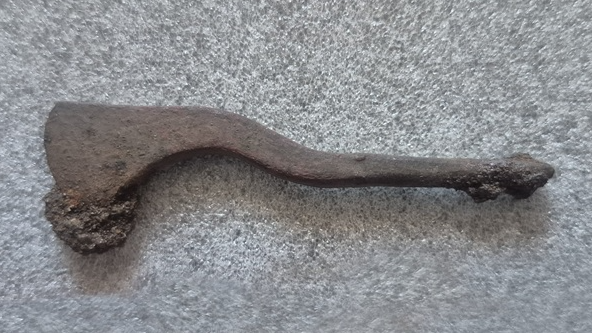2,300-year-old tool used for skull surgery unearthed at Celtic settlement in Poland
The uniquely shaped iron surgery implement dates to the fourth to third centuries B.C.

Archaeologists in Poland have discovered a rare iron tool that the Celts used to perform cranial surgery 2,300 years ago.
The hand-held artifact was found at Łysa Góra, a Celtic site in the Mazovia region of central-eastern Poland.
"The technique and precision of the iron object's manufacture indicate Celtic metallurgy," Bartłomiej Kaczyński, an archaeologist at the State Archaeological Museum in Warsaw, told Live Science in an email, and it was likely used to trepan a human skull.
From the Greek word meaning "to bore," trepanation is a form of cranial surgery that was practiced in many cultures around the world — including in what are now Spain, Israel and Bolivia — for at least 5,000 years, until the beginning of the 19th century.
There are a few trepanation methods, but most Celts appear to have used the "traditional scraping technique of trepanation," and only a minority of Celtic settlements practiced "drill trepanations," according to a 2007 study in the journal Neurosurgical Focus.
"The Celts practiced trepanation, as indicated by individual tools discovered in graves," Kaczyński said. "It seems that these operations had not only a magical but also a medical purpose."
But so far, they have found no skeletons of people who underwent the procedure at Łysa Góra.
Get the world’s most fascinating discoveries delivered straight to your inbox.
The presence of Celts — fierce warriors who were native to the European mainland and sacked Rome — was somewhat surprising, the team said, since Łysa Góra is the most northeastern Celtic site ever found in Europe.
Kaczyński and his team have been conducting new archaeological digs at Łysa Góra, which was first excavated in the 1970s, for two years.
In 2024, the archaeologists found hundreds of artifacts, including a rare Celtic helmet made of thin bronze sheet metal. And in the 2025 excavation, the team found Celtic brooches, a spearhead and an iron ax, as well as numerous metal objects related to horseback riding.
The trepanation tool, discovered this spring in the same part of the site as the helmet, is even rarer than the helmet, according to Kaczyński, because only a few of these surgical tools have been found at Celtic sites. This particular implement, which features a blade that transitions to a spike and was probably originally fastened to a wooden handle, is a type of ancient scalpel.
Kaczyński told Science in Poland that the presence of an iron trepanation scalpel means that the Celts who settled in the region likely included someone with specialized medical or ritual knowledge, as well as a blacksmith who could create the tools found at Łysa Góra.
The excavations at Łysa Góra have thus far revealed that it was a fortified settlement even before the Celts arrived in the fourth century. But once the Celts arrived, "traces of bronze and iron metallurgy, unique imports, fragmented bronze and amber objects all indicate that the settlement was a key center of trade," Kaczyński said.
Amber was a prized material in the Mediterranean world at this time, Kaczyński told Live Science in 2024, and the Celts may have fortified Łysa Góra to protect their place on the "amber trail."
Celtic quiz: Test your knowledge about these fierce tribes once described by Julius Caesar

Kristina Killgrove is a staff writer at Live Science with a focus on archaeology and paleoanthropology news. Her articles have also appeared in venues such as Forbes, Smithsonian, and Mental Floss. Kristina holds a Ph.D. in biological anthropology and an M.A. in classical archaeology from the University of North Carolina, as well as a B.A. in Latin from the University of Virginia, and she was formerly a university professor and researcher. She has received awards from the Society for American Archaeology and the American Anthropological Association for her science writing.
You must confirm your public display name before commenting
Please logout and then login again, you will then be prompted to enter your display name.


